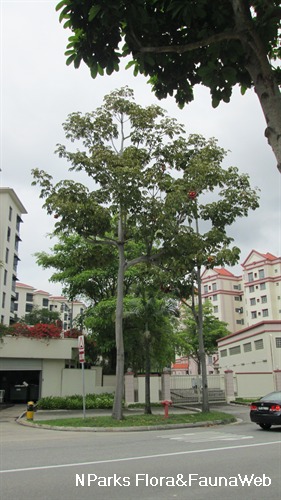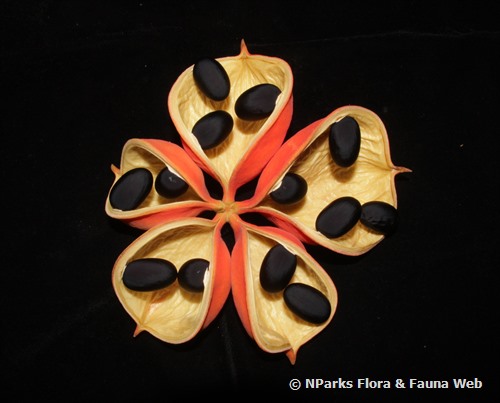
Back
Sterculia foetida L.
| Family Name: | Malvaceae |
| Synonyms: | Sterculia polyphylla R. Br. in Benn. & Br. |
| Common Name: | Hazel Sterculia, Kalupat, Kabu-Kabu, Kepoh, Indian Almond, Wild Almond, Java Olive, Skunk Tree, Bastard Poon Tree, Kelumpang, Kelumpang Jari, Kayu Lepong |
Name
Classifications and Characteristics
| Plant Division | Angiosperms (Flowering Seed Plants) (Dicotyledon) |
|---|---|
| Plant Growth Form | Tree (Big (>30m)) |
| Mode of Nutrition | Autotrophic |
| Maximum Height | 40 m |
| Tree or Palm – Trunk Diameter | 3 m |
Biogeography
| Native Distribution | From India, Sri Lanka, Bangladesh to Southeast Asia. |
|---|
Description and Ethnobotany
| Others - Plant Morphology | Growth Form: Large deciduous tree with horizontal, whorled branches. Habitat: Occurs in semi-open tropical forests and coastal areas. Trunk: Straight trunk has smooth, grey to whitish outer bark and fibrous inner bark. Foliage: Palmately compound leaves are clustered near the branch tips. Each leaf has a long petiole (12.5 - 23 cm long) and consists of 5 - 9 elliptic to lanceolate leaflets (10 - 17 cm long) with entire leaf margin. Flowers: This species is dioecious, having male and female flowers on separate trees. Pendent, foul-smelling flowers lack petals, but have a 5-lobed, red calyx that resembles petals. The lobes are deeply divided and curled backwards near the tip. The branched inflorescence is known as a panicle. Fruits: Dry, ellipsoid fruits known as follicles break open along 1 seam (7.6 - 9 cm long, 5 cm wide). Ripe fruits are bright red and contain 10 - 15 dull black, ellipsoid seeds (1.5 - 1.8 cm long). They eventually become brown and woody. Landscaping: The bright red fruits give this species an interesting look. It is best suited for parks, because the tree attains a massive size and may produce large buttress roots. It can also function as a shade tree. Although the flowers produce a bad smell, flowering only occurs once a year. Cultivation: This species should be planted in fertile, well draining soil that is kept moist. Specimens require large amounts of space to grow properly. Apply mulch near the base to help retain soil moisture. In India, a leaf-rolling insect known as Sylepta balteata is a serious pest of this species. Propagation: Propagate by seed or stem cuttings. Seeds have a long shelf life. Etymology: The genus "Sterculia" is named after the Roman god Sterculius, the god of manure. The reference is to the foul-smelling flowers of some species in this genus. The species epithet "foetida" means foul-smelling, referring to the flower's aroma. |
|---|---|
| Ethnobotanical Uses | Edible Plant Parts : Edible Seeds Cultural / Religious: Heritage Tree: There are 2 individuals of Sterculia foetida listed as Heritage Tree in Singapore. Both trees can be found in Singapore Botanic Gardens. To find out more about these trees, please visit the Heritage Tree Register. Others: Food: Seeds are edible. Other: The timber is easy to cut, but not durable. It is used locally to make items like canoes and hut doors. Fibres extracted from the bark can be processed into rope. The leaves can be used as fodder. |
Landscaping Features
| Desirable Plant Features | Ornamental Fruits, Fragrant (Flowers) (Day) |
|---|---|
| Landscape Uses | Suitable for Roadsides |
Fauna, Pollination and Dispersal
| Seed or Spore Dispersal | Abiotic (Gravity) |
|---|
Plant Care and Propagation
| Light Preference | Full Sun |
|---|---|
| Water Preference | Moderate Water |
| Plant Growth Rate | Moderate |
Foliar
| Mature Foliage Colour(s) | Green |
|---|---|
| Mature Foliage Texture(s) | Smooth, Glossy / Shiny |
| Foliar Shape(s) | Non-Palm Foliage (Lanceolate, Elliptical) |
| Foliar Margin | Entire |
| Foliar Apex - Tip | Acute |
| Foliar Base | Acute |
| Typical Foliar Area | Mesophyll ( 45cm2 - 182.25 cm2 ) |
| Leaf Area Index (LAI) for Green Plot Ratio | 3.0 (Tree - Intermediate Canopy) |
Floral (Angiosperm)
| Flower & Plant Sexuality | Unisexual Flowers , Dioecious |
| Flower Colour(s) | Red |
|---|
| Flower Symmetry | Radial |
| Inflorescence Type | Panicle |
| Flowering Habit | Polycarpic |
Fruit, Seed and Spore
| Mature Fruit Colour(s) | Red |
|---|---|
| Fruit Classification | Simple Fruit |
| Fruit Type | Dehiscent Dry Fruit , Follicle |
Image Repository
Others
| Master ID | 1844 |
|---|---|
| Species ID | 3137 |
| Flora Disclaimer | The information in this website has been compiled from reliable sources, such as reference works on medicinal plants. It is not a substitute for medical advice or treatment and NParks does not purport to provide any medical advice. Readers should always consult his/her physician before using or consuming a plant for medicinal purposes. |



.jpg)
.jpg)








